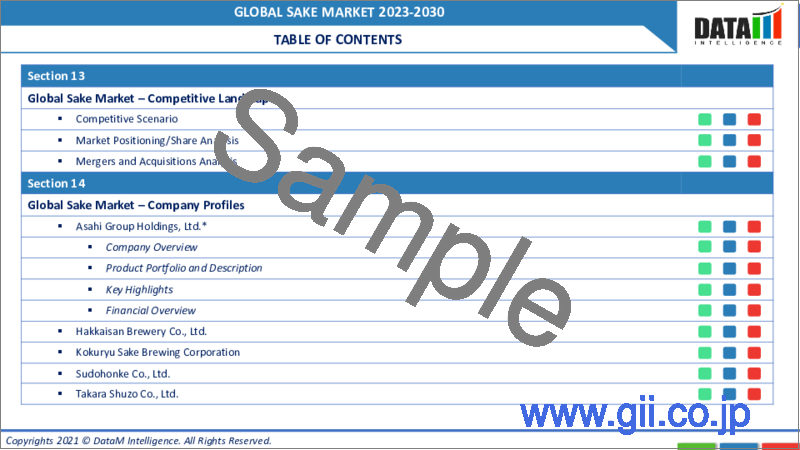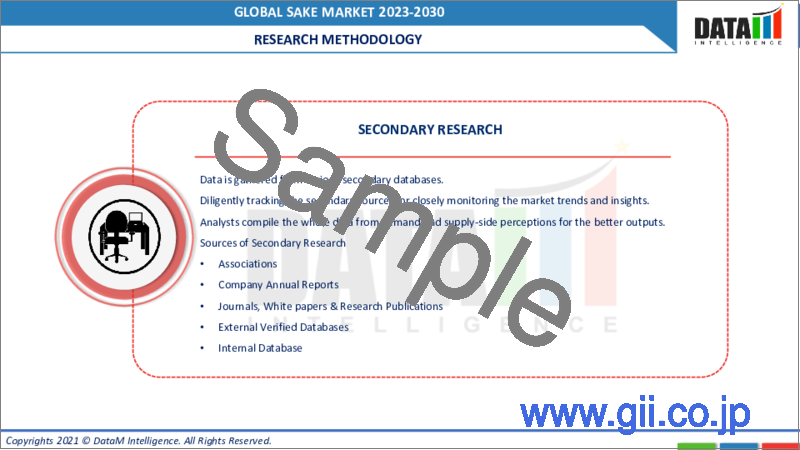|
|
市場調査レポート
商品コード
1304568
日本酒の世界市場-2023年~2030年Global Sake Market - 2023-2030 |
||||||
カスタマイズ可能
適宜更新あり
|
|||||||
| 日本酒の世界市場-2023年~2030年 |
|
出版日: 2023年07月07日
発行: DataM Intelligence
ページ情報: 英文 190 Pages
納期: 即日から翌営業日
|
- 全表示
- 概要
- 目次
市場概要
世界の日本酒市場は2022年に91億米ドルに達し、2030年には129億米ドルに達すると予測され、予測期間2023-2030年のCAGRは4.5%で成長すると予測されています。
日本酒は米を発酵させて造られるため、ライスワインと呼ばれることもあります。しかし、果実の糖分を発酵させて造るブドウ酒とは異なり、日本酒はビールと同様の醸造工程を経て造られます。日本酒の製造には、精米、麹菌の培養、発酵、ろ過などいくつかの工程があります。その過程では、慎重な職人技と伝統的な醸造技術の順守が求められます。日本酒の製造にはさまざまなタイプの米が使われ、米の品種の選択は日本酒の味、香り、そして全体的な品質に影響を与えます。山田錦や五百万石など、特別栽培の酒米は高級酒に好まれることが多くなっています。
プレミアムで高品質な日本酒は、世界規模でますます需要が高まっています。顧客は新しいものに課題することに前向きで、独特の風味、職人技、醸造方法のためなら、より高いお金を払うことを厭わないです。例えば日本の酒造会社は、その卓越性と複雑さで有名なプレミアム純米大吟醸酒の製造に力を注いでいます。
市場力学
グローバリゼーションの動向が日本酒市場を促進すると予想される
グローバリゼーションによって国際貿易ネットワークが拡大し、日本酒メーカーは製品をさまざまな国に輸出しやすくなっています。このような世界市場での日本酒の入手しやすさと流通の拡大は、日本酒業界の成長に寄与しています。日本の国税庁によると、日本酒の輸出額は2010年から2020年にかけてほぼ3倍に増加し、年間輸出額は241億4100万円(2億3,420万米ドル)に達しました。
グローバリゼーションは異文化間の料理交流をもたらし、人々は世界各地の料理をより積極的に探求し、評価するようになっています。寿司やラーメンといった日本料理の人気は、世界の日本酒消費量の増加に大きく貢献しています。
プレミアム化と製品革新が日本酒市場に顕著なチャンスをもたらす可能性
プレミアム化は、アルコール飲料分野を含む様々な産業で見られる世界の動向です。消費者は、高品質で個性的な製品にプレミアムを支払うことを望むようになっています。多様な風味と職人技を持つ日本酒は、プレミアム市場セグメントを獲得し、ユニークで洗練された飲酒体験を求める消費者に応える可能性を秘めています。ペンシルバニア州立大学が発表した調査によると、2021年には米国の消費者の24%が酒1本に50ドル以上を費やし、その割合は2022年には33%に拡大します。
日本酒の生産者は、提供する商品を差別化し、進化する消費者の嗜好に対応するために、新しい技術、原料、スタイルを模索しています。これには、熟成技術の実験、異なる米品種の使用、革新的な風味や醸造方法の採用などが含まれます。製品の革新は新たな消費者を惹きつけるだけでなく、既存の日本酒愛飲者にもこのカテゴリー内のさまざまな選択肢を探るよう促します。
他のアルコール飲料との競合が日本酒市場の足を引っ張る
アルコール飲料市場には、ビール、ワイン、スピリッツ、カクテルなど幅広い選択肢があります。消費者の嗜好は多様で、味覚プロファイルもさまざまです。こうした代替飲料が入手可能で多様なため、消費者の関心が日本酒からそれる可能性があり、市場の成長が制限されます。
地域や国によって、その文化に深く根ざした伝統的なアルコール飲料があります。例えば、欧米諸国ではワインやビールが好まれることが多いが、その他の地域では蒸留酒が重要な地位を占めています。こうした確立された飲酒習慣や文化的嗜好は、日本酒が従来の消費者層以外で大きな市場シェアを獲得することを困難にする可能性があります。
COVID-19影響分析
COVID-19分析には、COVID前シナリオ、COVIDシナリオ、COVID後シナリオに加え、価格力学(COVID前シナリオと比較したパンデミック中およびパンデミック後の価格変動を含む)、需給スペクトラム(取引制限、封鎖、およびその後の問題による需給の変化)、政府の取り組み(政府機関による市場、セクター、業界を活性化させる取り組み)、メーカーの戦略的取り組み(COVID問題を緩和するためにメーカーが行ったことをここで取り上げる)が含まれます。
ロシア・ウクライナ戦争の影響
地政学的緊張や紛争は、関税、禁輸、輸出入の困難を含む貿易の混乱や制限につながる可能性があります。こうした障壁は関係国間の日本酒の輸出入に影響を及ぼし、影響を受けた地域における日本酒の入手や流通に影響を与える可能性があります。地政学的紛争はしばしば経済的不安定をもたらし、消費者の購買力や市場全体の状況に影響を与えます。不確実性や景気後退は、日本酒のような特殊飲料を含む必需品以外への消費者支出の減少につながる可能性があります。
目次
第1章 調査手法と調査範囲
第2章 市場の定義と概要
第3章 エグゼクティブサマリー
第4章 市場力学
- 市場への影響要因
- 促進要因
- グローバリゼーションの進展
- 抑制要因
- 他のアルコール飲料との競合
- 機会
- プレミアム化と製品革新
- 影響分析
- 促進要因
第5章 業界分析
- ポーターのファイブフォース分析
- サプライチェーン分析
- 価格分析
- 規制分析
第6章 COVID-19分析
第7章 タイプ別
- 普通酒
- 純米酒
- 本醸造
- 純米吟醸
- 吟醸酒
- 純米大吟醸
第8章 年代別
- 20~40代
- 20-40歳
- 60歳以上
第9章 地域別
- 北米
- 米国
- カナダ
- メキシコ
- 欧州
- ドイツ
- 英国
- フランス
- イタリア
- スペイン
- その他欧州
- 南米
- ブラジル
- アルゼンチン
- その他南米
- アジア太平洋
- 中国
- インド
- 日本
- オーストラリア
- その他アジア太平洋地域
- 中東・アフリカ
第10章 競合情勢
- 競合シナリオ
- 市況/シェア分析
- M&A分析
第11章 企業プロファイル
- Hakutsuru Sake Brewing Co., Ltd.
- 会社概要
- 製品ポートフォリオと説明
- 財務概要
- 主な発展
- Ozeki Sake
- KANPAI London Craft Sake
- Aramasa Shuzo Co.
- Sun Masamune Pty Limited
- Takara Holdings Inc.
- Blue Current Brewery
- Asahishuzo CO., Ltd.
- Tatsuuma-Honke Brewing Co. Ltd.
- Gekkeikan Sake Co., Ltd
第12章 付録
Market Overview
The Global Sake Market reached US$ 9.1 billion in 2022 and is expected to reach US$ 12.9 billion by 2030 and is expected to grow with a CAGR of 4.5% during the forecast period 2023-2030.
Sake is sometimes called rice wine because it is made from fermented rice. However, unlike grape wine, which is produced through the fermentation of fruit sugars, sake is made through a brewing process similar to beer. Sake production involves several steps, including rice polishing, koji mold cultivation, fermentation, and filtration. The process requires careful craftsmanship and adherence to traditional brewing techniques. Different types of rice are used in sake production, and the choice of rice variety can impact the flavor, aroma, and overall quality of the sake. Specially cultivated sake rice varieties, such as Yamada Nishiki and Gohyakumangoku, are often preferred for premium sake.
Premium and high-quality sake are increasingly in demand on a global scale. Customers are open to trying new things and are willing to pay more for the sake of distinctive flavors, craftsmanship, and brewing methods. For instance, breweries in Japan have been concentrating on making the premium Junmai Daiginjo sake, which is renowned for its excellence and complexity.
Market Dynamics
The Increasing Trend of Globalization is Expected to Foster the Sake Market
Globalization has led to the expansion of international trade networks, making it easier for sake producers to export their products to various countries. This increased accessibility and distribution of sake in global markets contribute to the growth of the sake industry. According to the National Tax Agency of Japan, Japanese sake exports almost tripled from 2010 to 2020 with an annual export value of 24,141 million JPY (US$ 234.2 million).
Globalization has resulted in cross-cultural culinary exchanges, where people are more willing to explore and appreciate cuisines from different parts of the world. The popularity of Japanese cuisines, such as sushi and ramen, has significantly contributed to the increased consumption of sake globally.
Premiumization and Product Innovation can Show a Remarkable Opportunity in the Sake Market
Premiumization is a global trend observed across various industries, including the alcoholic beverage sector. Consumers are increasingly willing to pay a premium for high-quality and distinctive products. Sake, with its diverse range of flavor profiles and craftsmanship, has the potential to capture the premium market segment and cater to consumers seeking unique and refined drinking experiences. According to a study published by Pennsylvania State University, in 2021, 24% of consumers in the U.S. spent $50 or more on a bottle of alcohol, with the percentage growing to 33% in 2022.
Sake producers are exploring new techniques, ingredients, and styles to differentiate their offerings and cater to evolving consumer preferences. This includes experimenting with aging techniques, using different rice varieties, and incorporating innovative flavors or brewing methods. Product innovation not only attracts new consumers but also encourages existing sake drinkers to explore different options within the category.
Competition From Other Alcoholic Beverages is Holding Back the Sake Market
The alcoholic beverage market offers a wide range of options, including beer, wine, spirits, and cocktails. Consumers have diverse preferences and varying taste profiles. The availability and variety of these alternative beverages can divert consumer attention away from sake, limiting its market growth.
Different regions and countries have their traditional alcoholic beverages deeply rooted in their cultures. For example, in Western countries, wine and beer are often preferred, while spirits hold a prominent position in some other regions. These established drinking habits and cultural preferences can make it challenging for Sake to gain significant market share outside of its traditional consumer base.
COVID-19 Impact Analysis
The COVID-19 Analysis includes Pre-COVID Scenario, COVID Scenario, and Post-COVID Scenario along with Pricing Dynamics (Including pricing change during and post-pandemic comparing it with pre-COVID scenarios), Demand-Supply Spectrum (Shift in demand and supply owing to trading restrictions, lockdown, and subsequent issues), Government Initiatives (Initiatives to revive market, sector or Industry by Government Bodies) and Manufacturers Strategic Initiatives (What manufacturers did to mitigate the COVID issues will be covered here).
Russia-Ukraine War Impact
Geopolitical tensions and conflicts can lead to trade disruptions and restrictions, including tariffs, embargoes, or import/export difficulties. These barriers can affect the import and export of sake between the countries involved, potentially impacting the availability and distribution of sake in the affected regions. Geopolitical conflicts often create economic instability, affecting consumer purchasing power and overall market conditions. Uncertainty and economic downturn can lead to reduced consumer spending on non-essential goods, including specialty beverages like sake.q
Segment Analysis
The global sake market is segmented based on type, age group, and region.
By Age Group, People Belonging to the Age Group of 40-60 Years Old are Estimated to have Significant Growth During the Forecast Period
As individuals enter their 40s and beyond, they often develop a more refined palate and a greater appreciation for complex flavors. Sake, with its diverse range of styles, flavors, and craftsmanship, appeals to individuals who seek unique and sophisticated drinking experiences.
By their 40s and 50s, individuals have typically had more exposure to different cultures, including Japanese cuisine and traditions. The familiarity with Japanese culture, along with a sense of curiosity and willingness to explore new experiences, can drive the interest in and consumption of sake.
Geographical Analysis
Europe is the Fastest Growing Market in the Sake Market
Japanese cuisine, including sushi, ramen, and other traditional dishes, has gained significant popularity in Europe. As consumers become more familiar with Japanese food culture, there is a corresponding interest in pairing sake with these culinary experiences. This growing interest in Japanese cuisine creates a favorable environment for the growth of the sake market in Europe.
Europe has experienced increased cultural exchange and globalization, leading to greater exposure to different cultural traditions and products. Sake, as a traditional Japanese beverage, is gaining recognition as part of this cultural exchange. According to Japan Sake and Shochu Makers Association, France recorded the highest percentage of growth in both total value and volume with a 230.3% increase in value and a 197.5% increase in volume compared to 2020. The expanding multicultural environment contributes to the growing demand and consumption of sake in Europe.
Competitive Landscape
The major global players in the market include: Hakutsuru Sake Brewing Co., Ltd., Ozeki Sake, KANPAI London Craft Sake, Aramasa Shuzo Co., Sun Masamune Pty Limited, Takara Holdings Inc., Blue Current Brewery, Asahishuzo CO., Ltd., Tatsuuma-Honke Brewing Co. Ltd., and Gekkeikan Sake Co., Ltd.
Why Purchase the Report?
- To visualize the global Sake market segmentation based on type, age group, and region, as well as understand key commercial assets and players.
- Identify commercial opportunities in the market by analyzing trends and co-development.
- Excel data sheet with numerous data points of Sake market-level with all segments.
- The PDF report consists of cogently put-together market analysis after exhaustive qualitative interviews and in-depth market study.
- Product mapping is available as Excel consists of key products of all the major market players.
The global Sake market report would provide approximately 53 tables, 50 figures and 190 pages.
Target Audience 2023
- Manufacturers/ Buyers
- Industry Investors/Investment Bankers
- Research Professionals
- Emerging Companies
Table of Contents
1. Methodology and Scope
- 1.1. Research Methodology
- 1.2. Research Objective and Scope of the Report
2. Market Definition and Overview
3. Executive Summary
- 3.1. Market Snippet, by Type
- 3.2. Market Snippet, by Age Group
- 3.3. Market Snippet, by Region
4. Market Dynamics
- 4.1. Market Impacting Factors
- 4.1.1. Drivers
- 4.1.1.1. Increasing Trend of Globalization
- 4.1.2. Restraints
- 4.1.2.1. Competition from Other Alcoholic Beverages
- 4.1.3. Opportunity
- 4.1.3.1. Premiumization and Product Innovation
- 4.1.4. Impact Analysis
- 4.1.1. Drivers
5. Industry Analysis
- 5.1. Porter's Five Force Analysis
- 5.2. Supply Chain Analysis
- 5.3. Pricing Analysis
- 5.4. Regulatory Analysis
6. COVID-19 Analysis
- 6.1. Analysis of COVID-19 on the Market
- 6.1.1. Scenario Before COVID-19
- 6.1.2. Scenario During COVID-19
- 6.1.3. Scenario Post COVID-19
- 6.2. Pricing Dynamics Amid COVID-19
- 6.3. Demand-Supply Spectrum
- 6.4. Government Initiatives Related to the Market During Pandemic
- 6.5. Manufacturers Strategic Initiatives
- 6.6. Conclusion
7. By Type
- 7.1. Introduction
- 7.1.1. Market Size Analysis and Y-o-Y Growth Analysis (%), By Type
- 7.1.2. Market Attractiveness Index, By Type
- 7.2. Ordinary Sake*
- 7.2.1. Introduction
- 7.2.2. Market Size Analysis and Y-o-Y Growth Analysis (%)
- 7.3. Junmai
- 7.4. Honjozo
- 7.5. Junmai Ginjo
- 7.6. Ginjo
- 7.7. Junmain Daiginjo
8. By Age Group
- 8.1. Introduction
- 8.1.1. Market Size Analysis and Y-o-Y Growth Analysis (%), By Age Group
- 8.1.2. Market Attractiveness Index, By Age Group
- 8.2. 20-40 Years Old*
- 8.2.1. Introduction
- 8.2.2. Market Size Analysis and Y-o-Y Growth Analysis (%)
- 8.3. 20-40 Years Old
- 8.4. Above 60 Years Old
9. By Region
- 9.1. Introduction
- 9.1.1. Market Size Analysis and Y-o-Y Growth Analysis (%), By Region
- 9.1.2. Market Attractiveness Index, By Region
- 9.2. North America*
- 9.2.1. Introduction
- 9.2.2. Key Region-Specific Dynamics
- 9.2.3. Market Size Analysis and Y-o-Y Growth Analysis (%), By Type
- 9.2.4. Market Size Analysis and Y-o-Y Growth Analysis (%), By Age Group
- 9.2.5. Market Size Analysis and Y-o-Y Growth Analysis (%), By Country
- 9.2.5.1. The U.S.
- 9.2.5.2. Canada
- 9.2.5.3. Mexico
- 9.3. Europe
- 9.3.1. Introduction
- 9.3.2. Key Region-Specific Dynamics
- 9.3.3. Market Size Analysis and Y-o-Y Growth Analysis (%), By Type
- 9.3.4. Market Size Analysis and Y-o-Y Growth Analysis (%), By Age Group
- 9.3.5. Market Size Analysis and Y-o-Y Growth Analysis (%), By Country
- 9.3.5.1. Germany
- 9.3.5.2. The U.K.
- 9.3.5.3. France
- 9.3.5.4. Italy
- 9.3.5.5. Spain
- 9.3.5.6. Rest of Europe
- 9.4. South America
- 9.4.1. Introduction
- 9.4.2. Key Region-Specific Dynamics
- 9.4.3. Market Size Analysis and Y-o-Y Growth Analysis (%), By Type
- 9.4.4. Market Size Analysis and Y-o-Y Growth Analysis (%), By Age Group
- 9.4.5. Market Size Analysis and Y-o-Y Growth Analysis (%), By Country
- 9.4.5.1. Brazil
- 9.4.5.2. Argentina
- 9.4.5.3. Rest of South America
- 9.5. Asia-Pacific
- 9.5.1. Introduction
- 9.5.2. Key Region-Specific Dynamics
- 9.5.3. Market Size Analysis and Y-o-Y Growth Analysis (%), By Type
- 9.5.4. Market Size Analysis and Y-o-Y Growth Analysis (%), By Age Group
- 9.5.5. Market Size Analysis and Y-o-Y Growth Analysis (%), By Country
- 9.5.5.1. China
- 9.5.5.2. India
- 9.5.5.3. Japan
- 9.5.5.4. Australia
- 9.5.5.5. Rest of Asia-Pacific
- 9.6. Middle East and Africa
- 9.6.1. Introduction
- 9.6.2. Key Region-Specific Dynamics
- 9.6.3. Market Size Analysis and Y-o-Y Growth Analysis (%), By Type
- 9.6.4. Market Size Analysis and Y-o-Y Growth Analysis (%), By Age Group
10. Competitive Landscape
- 10.1. Competitive Scenario
- 10.2. Market Positioning/Share Analysis
- 10.3. Mergers and Acquisitions Analysis
11. Company Profiles
- 11.1. Hakutsuru Sake Brewing Co., Ltd.*
- 11.1.1. Company Overview
- 11.1.2. Product Portfolio and Description
- 11.1.3. Financial Overview
- 11.1.4. Key Developments
- 11.2. Ozeki Sake
- 11.3. KANPAI London Craft Sake
- 11.4. Aramasa Shuzo Co.
- 11.5. Sun Masamune Pty Limited
- 11.6. Takara Holdings Inc.
- 11.7. Blue Current Brewery
- 11.8. Asahishuzo CO., Ltd.
- 11.9. Tatsuuma-Honke Brewing Co. Ltd.
- 11.10. Gekkeikan Sake Co., Ltd
LIST NOT EXHAUSTIVE
12. Appendix
- 12.1. About Us and Services
- 12.2. Contact Us






